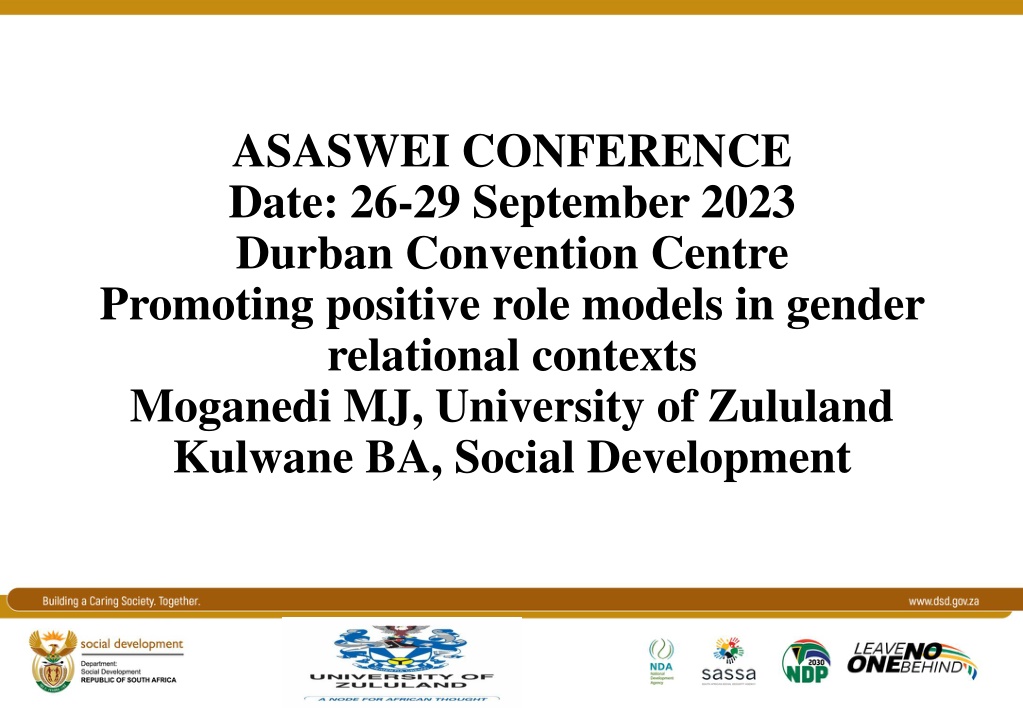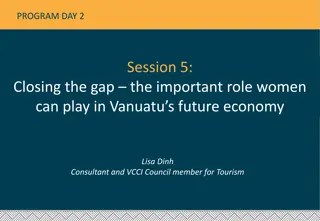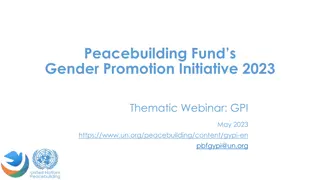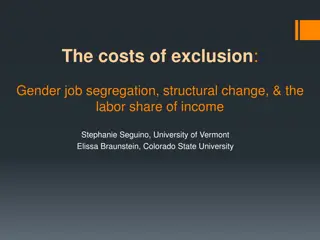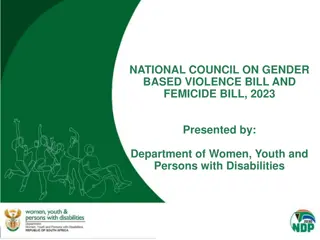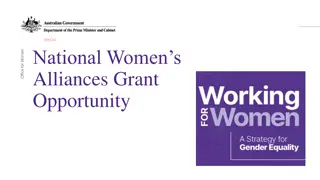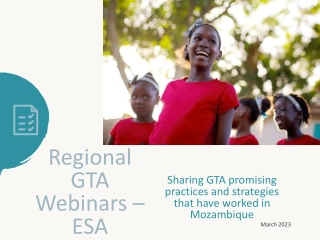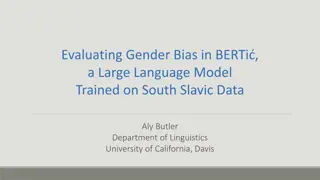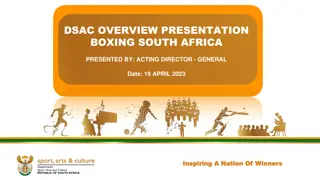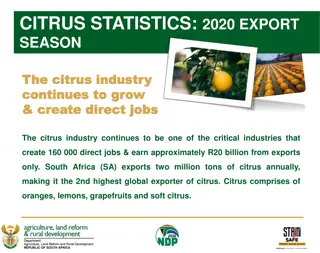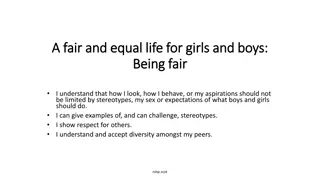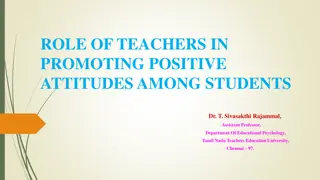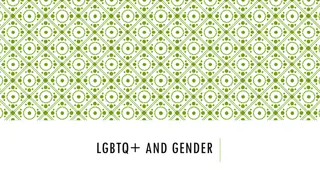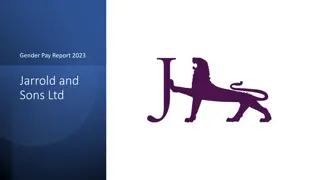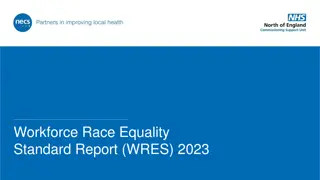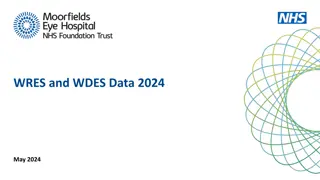Empowering Men for Gender Equality: Case Study on Positive Role Models in South Africa
The study explores the effectiveness of men's organizations in promoting gender equality and curbing gender-based violence in South Africa. It discusses policies, initiatives, and challenges while highlighting the importance of engaging men in transforming gender relations. The research employs a qualitative approach with a focus on three men's programs and their impact on societal change.
Download Presentation
Please find below an Image/Link to download the presentation.
The content on the website is provided AS IS for your information and personal use only. It may not be sold, licensed, or shared on other websites without obtaining consent from the author. Download presentation by click this link. If you encounter any issues during the download, it is possible that the publisher has removed the file from their server.
Presentation Transcript
ASASWEI CONFERENCE Date: 26-29 September 2023 Durban Convention Centre Promoting positive role models in gender relational contexts Moganedi MJ, University of Zululand Kulwane BA, Social Development
Introduction The dawn of the 21st Century saw a proliferation of men s organisations in many parts of the globe including South Africa. These have become ubiquitous in South African communities and have demonstrated a readiness to play a meaningful role in development of policy that is aimed at improving gender relations. Problem Statement The South African government developed policies, strategies and programmes to address societal problems such as gender inequality and gender related crimes in line with UN goals and protocols. Cases of GBV and Femicide continued to rise in South African communities despite the progressive policies and strategies. Majority of perpetrators are men while women and children, girls in particular, are found to be the most vulnerable to gendered victimization. South Africa s progressive legislation and policy is meant to protect the vulnerable in line with the rights contained in the Constitution. These inspired the emergence of men s groupings in many of the country s communities. Questions are being asked around the effectiveness of these policies and the role of men in the transformation of gender relations and the curbing of GBV.
Theoretical Framework (Gender Transformative Approaches) Gita Rao Gupta is credited for the emergence of gender transformative approaches of engaging men and boys in the creation of gender equality. In her year 2000 lecture she outlined a continuum of five intervention categories in addressing gender, sexuality and HIV among men. These occur in a continuum in the process of transformation of an individual man (Gupta 2000) in Casey et al. (2016). Gupta s five categories are: reinforcement of gender and sexuality stereotypes; gender neutrality; gender sensitive; gender transformative; and gender empowering. Casey et al. (2016) identified three gender transformation domains that are relevant for the engagement of men. The first is the initial outreach to men, followed by attitude and behaviour change and the third is the social activism to advocate for gender reforms and recruit more men.
Methodology A qualitative approach with a case study design. Three men s programmes were identified and found to have emerged at different stages. They were also found to have had some influence on each other. Sampling Purposive sampling and review of documents with a focus on involvement of men in gender related issues and also as positive role models. Data Collection and Analysis Desk-top review for data collection and analysis of reviewed documents for a deeper understanding of issues.
Towards the National Strategic Plan on Gender Based Violence and Towards the National Strategic Plan on Gender Based Violence and Femicide 1. National Strategy on Engagement of Men & Boys in Prevention of GBV 1. National Strategy on Engagement of Men & Boys in Prevention of GBV Femicide (GBVF 2020 (GBVF 2020 2030) 2030) National Men s Consultative workshop on 28 Feb 2008 afforded men opportunity to make their voices heard in strategy developmen t 2004 National Gender Machinery mandate for DSD to lead UN Commission on Status of Women s 48th session theme: Engagement of Men & Boys in Achieving Gender Equality Strategy on Engageme nt of Men & Boys in prevention of GBV came into existence in 2008 DSD Men in Action campaign mission culminating in National Summit on Men & Boys in Dec 2005 Summit enabled developm ent of Strategic Framewor k in 2006
Towards the National Strategic Plan on Gender Based Violence and Towards the National Strategic Plan on Gender Based Violence and Femicide 2. Programme of Action on Violence Against Women & Children (POA: VAWC 2013 2. Programme of Action on Violence Against Women & Children (POA: VAWC 2013 2018) Femicide (GBVF 2020 (GBVF 2020 2030) 2030) 2018) Chaired by the Minister of Social Development, the IMC developed the integrated Programme of Action on Violence Against Women and Children (POA: VAWC 2013 2018) Gender Based Violence Command Centre (GBVCC) telephonic counselling & referral service is one of the VAWC highlights POA: VAWC with three Pillars approved by Cabinet in September 2013 . Urgent need for national action due to escalation of GBV and Femicide led to IMC in May 2012 to develop comprehensi ve strategy on VAWC Men and Boys issues relegated to bottom of priority list
Towards the National Strategic Plan on Gender Based Violence and Towards the National Strategic Plan on Gender Based Violence and Femicide 3. 3. Diagnostic Review of the State Response to VAWC (2016 Diagnostic Review of the State Response to VAWC (2016 Femicide (GBVF 2020 (GBVF 2020 2030) 2030) To assess effectiveness of government interventions in VAWC and manner in which they can be strengthened. Six Recommendations from Diagnostic Review: Revitalize, strengthen & relaunch POA, establishing a common conceptual framework, incorporating new evidence from recent studies, consulting more broadly, aligning with departmental performance frameworks and ensuring that funds are appropriated to planned initiatives. Establish a body to provide oversight and coordination to the sector, ensure accountability, and monitor progress against government s goal to eliminate VAWC. Third, fourth and fifth recommendations were about strengthening data collection and management and also building a stronger evidence base of what works through evaluations of both government and NPO implemented programmes. Final recommendation was for the DSD to lead in comprehensively defining the psychosocial response services.
Towards the National Strategic Plan on Gender Based Violence and Towards the National Strategic Plan on Gender Based Violence and Femicide 4. The National Strategic Plan on Gender Based Violence and 4. The National Strategic Plan on Gender Based Violence and Femicide Femicide (GBVF 2020 (GBVF 2020 2030) Femicide (GBVF 2020 (GBVF 2020 2030) 2030) 2030) The #TTS protest action coincided with provincial consultations on the DSD s review of the 2013 2018 (POA VAWC). Review meant to address recommendat ions of Diagnostic Review. President signed Summit Declaration on 28 March 2019 with drafting of NSP GBVF as a priority. He approved NSP GBVF in March 2020 1st August 2018 #TheTotalShut down (#TTS) protest marches in provinces called for the elimination of GBVF in the country. Total of 19 marches Memorandum of 24 demands was delivered with one of them calling for the President to convene a multi- stakeholder summit on GBV by the 31st August 2018. DSD review halted for officials to focus on preparations for Presidential Summit which was held on 1st and 2nd November 2018
Six Pillars of NSP on GBVF (2020 - 2030) DSD assigned role of leading Pillar 4 (Response, Care Support & Healing) and support Pillar 2 (Prevention and Rebuilding of Social Cohesion) Presidential Summit 2 themed Accountability, Acceleration and Amplification, Now! held on 1st & 2nd Nov. 2022
Towards the National Strategic Plan on Gender Based Violence and Towards the National Strategic Plan on Gender Based Violence and Femicide 5. The voices of men and boys 5. The voices of men and boys Femicide (GBVF 2020 (GBVF 2020 2030) 2030) Effective Men & Boys mobilization methods already in existence e.g. Sonke s OMC and Stepping Stones. OMC found to have been effective in men s attitude and behaviour change in Limpopo, Mpumalanga & EC (Mokganyetji et al. (2016). Critical issues raised in Feb 2008 Men s Consultative Workshop were being addressed outside of the DSD by CSO partners. No clarity on formal consultation of SANAC Men s Sector in development of NSP GBVF and Sector s contribution in Pillar 2 Prevention & Rebuilding of Social Cohesion . Takuwani Riime held biennial Men s and Traditional Men s Parliaments plus Boys Assemblies since 2018. The movement also expressed a commitment to contribute in implementation of NSP GBVF (Pillar 2) and NSP HIV/AIDS Goal 4 Takuwani Riime Men s Movement tasked in 2017 to support DSD in implementation of NSP HIV/AIDS Goal 4 on addressing the social and structural drivers of HIV. TB and STIs. Already involved a=in social and behavioural change programs.
Theoretical Perspective Theoretical Perspective Gender Transformative Approaches (Three Gender Transformative Approaches (Three Domains) Casey et al. (2016) Domains) Casey et al. (2016) 2. Attitude and behaviour change for men and boys 1. Initial Outreach to men Include invitations and recruitment Systematic approach speaking to men s desires and allay their fears of stigma. Recruit men through : Their trusted networks; Cultural context; Their personal and emotional connection; through hopefulness and, through hooks conversations with topics related to men s concerns e.g. fatherhood and sexual health. (Dworkin et al. 2012 and Piccigallo et al. 2012) 1. Initial outreach to men and boys 3. Ongoing social action and community Potentially engaged men and boys
Theoretical Perspective Theoretical Perspective Gender Transformative Approaches Gender Transformative Approaches (Three Domains) Casey et al. (2016) (Three Domains) Casey et al. (2016) 2. Attitude and Behaviour Change Dworkin et al. (2012) Impact on men s attitudes and behaviour in areas such as use of violence, gender norms, increase in care and domestic work, and social acceptance of IPV. 2. Attitude and behaviour change for men and boys 1. Initial outreach to men and boys 3. Ongoing social action Potentially engaged men and boys
Theoretical Perspective Theoretical Perspective Gender Transformative Approaches Gender Transformative Approaches (Three Domains) Casey et al. (2016) (Three Domains) Casey et al. (2016) 2. Attitude and behaviour change for men and boys Men recruited during initial outreach and empowered with attitude and behaviour changing knowledge have gained confidence to push for social change in gender norms for impact on gender justice. Social activism also meant to advocate for institutionalization of prevention programming through system-level interventions (Pease 2008) Takuwani Riime s efforts to institutionalize men s movement through partnership with government in sector parliamentary process Effective social action is buttressed by the degree to which individual engaged men carry forward and actively embody support for gender equitable behaviour, norms,, and policies in their networks, institutions and communities Casey et al. (2016) 1. Initial outreach to men and boys 3. Ongoing social action Potentially engaged men and boys
Sonkes Sonke s One Man Can One Man Can (OMC) Campaign (OMC) Campaign OMC INTERVENTION RESULTS (In relation to Gender Transformative Approach) 1. Improved awareness and knowledge of the impact of GBV and increased commitment to address the problem, particularly among men (Attitude & behaviour change leading to social action). 2. Sonke s partner organisations gained capacity and confidence to independently implement OMC and integrate campaign s activities programmes (Social Activism). 3. Better understanding of the relationship between gender norms and roles, toxic masculinities and both GBV and HIV/AIDS among key community stakeholders such as traditional leaders, local authorities, teachers, religious leaders and other partners. OMC also inspired commitment to address these issues (Institutionalization of social activism). 4. Positive attitudes found in social norms, attitudes and behaviour related to GBV and gender equality resulting in reduction of GBV in 11 targeted villages. OMC INTERVENTION 11 randomized to receive OMC community mobilization interventions and another 11 as controlled comparison. Workshops, door-to-door, matches, street theatre, murals, video screenings and discussions facilitated by community mobilizers and Community Action Team (Gender Transformative Approach s Initial Outreach Domain). All villages monitored for GBV incidences including rape, HIV prevalence, men s health seeking behaviour, reported habits of condom use, HIV testing etc. of 25 Bushbuckridge villages in their own soccer NB. OMC success in fight against the spread of HIV can be replicable in fighting GBV and Femicide.
Towards the National Strategic Plan on Gender Based Violence and Towards the National Strategic Plan on Gender Based Violence and Femicide Takuwani Takuwani Riime Femicide (GBVF 2020 (GBVF 2020 2030) 2030) Riime Men s Movement Men s Movement Venda language expression of Let Us Stand Up Together! Led by Deputy Minister Bogopane- Zulu of DSD, Takuwani Riime partnered with government to organize Boys Assemblies, Men s Parliaments and Traditional Men s Parliaments since 2018. Assisting DSD in implementation of Goal 4 of the NSP HIV/AIDS following 2017 review which mandated the department to lead on social and structural causes of TB, HIV and STIs. Attitude and behavioural change programme. Founded in 2015 and currently engaged in consultations on the finalization of a Men s Charter. Conceptualized within the Men s Sector of SANAC and informed by the connection between HIV/AIDS and GBV A calling on all men to be part of institutionalizing a responsive men s movement. A renaissance movement of male gender activists committed to changing gender norms and gender relations. Motto is : Men Championing Change!
Towards the National Strategic Plan on Gender Based Violence and Towards the National Strategic Plan on Gender Based Violence and Femicide Selected quotes from speeches at Boys Assemblies and Men s Parliaments Selected quotes from speeches at Boys Assemblies and Men s Parliaments Femicide (GBVF 2020 (GBVF 2020 2030) 2030) We are building community care centres across the country in deep rural areas under traditional leadership. We are also promoting community-based intervention and rehabilitation led by Amakhosi, the Deputy Minister Bogopane Zulu Let us not tolerate jokes that promote sexism and gender violence!, said the UN representative at the launch of the Traditional Men s Parliament in September 2021. We want to use the Men Championing Change programme to acknowledge that men and boys are equal members of society who live within families and communities. Our priority is to develop a strong front of men who educate other men and inspire positive change that subsequently result in preventionof new HIV infections and gender based violence Takuwani Riime s Dr Matome Kganaga at the launch of Men Championing Change (2018) We need to ensure that the boy child is heard and socialised appropriately so that he becomes a better man tomorrow, Rev. Zwo Nevhutali of SANAC at the Boys Assembly of 18 October 2018 We ve focused so much on empowering the girl child with aim to address gender inequalities that we ve indirectly ignored the boy child. This is problematic because the two co-exist so you cannot empower the one without the other. I want to say to all boys gathered here today you are gathered here so that you can return to your communities as champions of change. Ms Gloria Khoza, UNICEF Rep. at the Boys Assembly of 18 October 2018. Traditional leaders were accused of promoting cultural practices that oppressed women. We are here today to declare as traditional leaders that we have taken a stand to discourage harmful cultural practices that discriminated against women said Nkosikazi Mhlauli at the launch of the Traditional Men s Parliament, 17 September 2021
Conclusion & Recommendations Conclusion & Recommendations The theme of The Role of Men and Boys in the Achieving Gender Equality at the 48th Session of the UN Commission on the Status of Women in March 2004 was informed by Goal 3 of the MDGs( 2000 2015) which was later replaced by Goal 5 of the SDGs (2015 2030). The MDG goal read as Promote Gender Equality and empower women and the SDG goal as Achieve gender equality and empower all women and girls . Achievement of these goals may also contribute to realization of the African Union s Agenda 2063: The Africa we want. One of the Agenda s transformational outcomes is empowered women, youth and children. South Africa s progressive legislative and policy reforms are geared towards achievement of these goals and the country s men are positioning themselves to play an active role as change agents. There is therefore a need for upscaling of successful intervention approaches such as the OMC in development of Takuwani Riime's Men Championing Change dialogues. The 2020 2022 Takuwani Riime sMen s Movement Programme of Action has to be reviewed and effective community dialogue facilitation methods adopted for meaningful and gender transformative engagements that can lead to critical introspection by ordinary men and boys for positive attitude and behaviour change. These will certainly contribute immensely to the institutionalisation of the movement in the South African society. Lastly, the Men s Sector and Takuwani Riime should ensure that the Men Championing Change activities are formally reported under Pillar 2 of the GBVF Strategy as well as Goal 4 of the HIV/AIDS Strategy.
